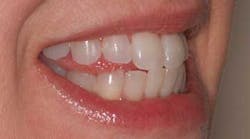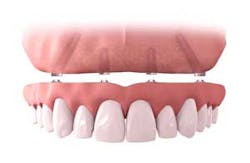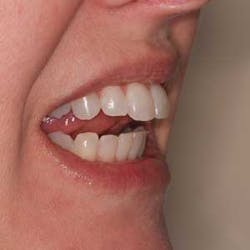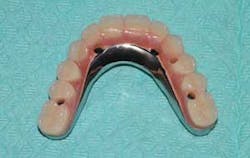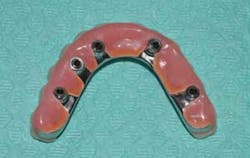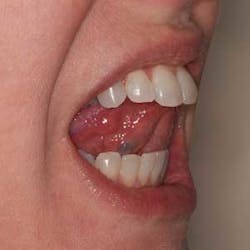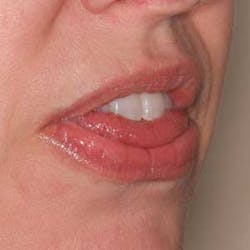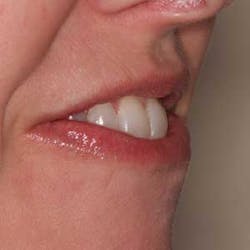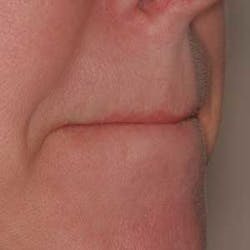This article first appeared in the newsletter, DE's Breakthrough Clinical with Stacey Simmons, DDS. Subscribe here.
Speech difficulties are common complications that patients experience during the restorative process of full-arch All-On-4 hybrid cases (figure 1).
Figure 1: Full-arch All-On-4
The bulk of the prosthetic places a strain on phonetics, and the restorative dentist must work to find the best compromise among dental implant positions, framework bulk for strength, adequate volume of acrylic to support the denture teeth, and the patient’s ability to speak clearly.
ALSO BY DR. JOHN HODGES |Claspless, removable partial dentures using implant-supported Locator attachments
These complications are compounded when using an immediate fixed provisional. Speech problems are common with full-denture and veneer cases. However, with dentures the clinician has the luxury of working out many of the speech issues in wax prior to the final restoration and knows exactly which teeth were modified in a veneer case, making it easier to focus on the specific problem area. With immediate fixed provisionals, we open the door to multiple factors that can affect speech even if a wax try-in was performed.
Patients are given anesthetic and often sedated. It is difficult, especially in the mandible, to find enough bony support to replicate the position of the initial denture as it was on the model. The mandible often retrudes as the patient lies supine and sedated, struggling to find the proper biting position as he or she becomes more lucid. By the time the provisional is screwed into the implants, the clinician often has modified the vertical dimension of occlusion (VDO), the class of occlusion, and the incisal edge position either by choice or in error. Additional complications include possible changes in arch width and restricted tongue space due to the bulk of the provisional. After a few weeks of healing, the patient often complains of speech problems. What is the clinician to do? Which factors are causing the speech issues? Where can adjustments be made?
ADDITIONAL READING | Anterior dental implant cases: Fixed temporaries for greater case acceptance and better soft-tissue outcomes
Several good articles address the ideal tooth setup and detailed adjustments; you can find these in the references at the end of this article. This article is designed to act as a reference guide in diagnosing the source of speech complications after the hybrid provisional has been fabricated. I am a huge supporter of working out all of the clinical and emotional issues with the provisional prior to fabricating the final bridge. The transition into the final bridge should be a smooth one.
When a patient experiences speech complications, my first course of action is adaptation. With veneer cases, it is often suggested that we wait four weeks for the patient to adapt to the new tooth position prior to adjusting. (1) Due to the complexities associated with the bulk of the hybrid provisional, I prefer to wait eight weeks prior to making adjustments. Even if the patient continues to struggle with phonetics, the eight-week period often helps to isolate specific sounds that are problematic.
I group the primary sounds affected by hybrids into five groups: tongue to hard palate (D, N, T), tongue to teeth (L, TH), teeth to teeth (S, SH, Z), teeth to lip (F, V), and lip to lip (B, M, P). (2) Isolate the sound or sounds that the patient struggles with, and then focus on changes that can be made according to the group the sound fits into.
Tongue to hard palate (D, N, T) (figure 2) . . .
Figure 2: Tongue to hard palate (D, N, T)
This is the second most common group of sounds that my patients struggle with. Horizontal bone loss in the premaxilla often results in the surgeon needing to position the implants lingually for adequate facial bone volume. Surgeons also place the implants lingually to assist the restorative doctor with placing the screw access holes 2 mm or more behind the lingual surfaces of the anterior teeth. This implant positioning is proper, all things considered, but it results in the prosthesis covering the incisive papilla region. “D,” “N,” and “T” sounds are formed when the tip of the tongue lightly touches the palate at the incisive papilla. (3)
To correct or minimize this complication, I recommend always using a surgical guide of the planned final restoration position so that the surgeon can avoid placing the implants too far lingually. Once the patient is in the provisional, I adjust this area to be as thin as possible while still keeping enough bulk for strength (3–4 mm of acrylic lingual to the access hole in the provisional). I may choose to replace an angled abutment with one of a lesser angle in order to move the screw access hole closer to the teeth, thus allowing for less bulk of acrylic lingual to the screw access hole. In a compromise of having a patient struggle with these sounds versus moving a screw access hole closer to the teeth, I typically choose to do the latter (thus lessening acrylic support for the tooth). Afterward, I carefully manage occlusion in this area.
Lastly, innovative prosthetic designs from laboratories are allowing for thinner bulk in this region in the final titanium-framed restorations (figures 3 and 4).
Figures 3 and 4: Final titanium-framed restorations (Design courtesy of Allister Gibbons, CDT, Issaquah Dental Lab)
If the patient still experiences speech problems after the provisional is adjusted, talk to your lab about design options.
Tongue to teeth (L, TH) (figures 5 and 6) . . .
Figures 5 and 6: Tongue to teeth (L, TH)
The “L” sound is formed when the lingual tip of the tongue contacts the lingual of the maxillary anterior teeth. (3) If the anterior teeth are placed too far forward or too far lingually, this sound may be affected. (4) In my experience, the “L” is more affected when the teeth are placed too far lingually. If it is obvious that this is the case, you must make a new provisional to move the teeth more facially. Spend a lot of time on the wax try-in having patients make the “L” sound until you are confident that the teeth are in the correct position. If you suspect that the teeth are placed too far to the facial, you can add composite or acrylic to the lingual of teeth Nos. 7–10 to see if speech improves prior to making permanent changes.
The “TH” sound is formed when the tip of the tongue passes through the anterior teeth, having light contact with the maxillary teeth. (2) If too little freeway space (separation between the upper and lower teeth) is present, this may affect the “TH” sound by restricting tongue movement. If the anterior teeth are too high or too low, this sound may be affected. First check the freeway space. There should be a minimum of 2–3 between maximum intercuspation and the rest position. If you suspect that the teeth are set too low, you can reduce them with a bur to see if the “TH” sound improves. Have the patient repeatedly say “thirty-three” to assess this sound. If the teeth are set too high, then you can add composite to the maxillary anteriors to see if the sound improves.
Teeth to teeth (S, SH, Z) (figure 7) . . .
Figure 7: Teeth to teeth (S, SH, Z)
For doctors who restore a lot of full-arch implant-supported cases, the “S” sound is the bane of their existence. Often, struggles with “S” are in addition to struggles with “SH” and “Z.” “S” and “SH” are by far the sounds that my patients struggle with the most. This is because the hybrid prosthesis affects so many aspects of forming these sounds. Air flow under the bridge must be controlled, anterior tooth positioning and length must be accurate, and posterior arch width must not be too constrictive.
Fortunately, the most common “S” sound complication that arises with immediate provisionals is also the easiest to fix. As the soft tissue heals following surgery, a gap often opens up between the soft tissue and the intaglio surface of the maxillary provisional. This can result in a whistling sound. If enough healing has occurred that the surgeon feels safe having the bridge removed, do nothing more than remove the bridge and reline the intaglio until light tissue contact is achieved. If it is unsafe to remove the bridge, flowable composite or acrylic can be used to create a tissue seal on the palatal side of the bridge to prevent whistling until a more secure reline can be performed. Whistling is not uncommon with mandibular provisionals since air minimally passes under the bridge during speech.
Anterior tooth position plays a big role in “S” sound complications since the anterior teeth come into light contact while making the sound. (5) Too much contact often results in a lisp. You may need to adjust the incisal length of the teeth. If the maxillary anteriors are esthetically in the correct position, then shorten the mandibular teeth. (1) If the maxillary teeth appear too long, shorten them. Have the patient say “sixty-six” repeatedly to assist you in finding the ideal position. Be aware that if the mandibular teeth are natural, they may supra-erupt and the lisp may return. (1)
The last factor is a tongue-to-teeth issue, but I have grouped it here due to the sounds it affects. That factor is posterior arch width. These sounds, especially “SH,” are impacted by the tongue contacting the teeth in the posterior. (6) Many patients who require full-arch restoration lost their posterior teeth long ago. Their tongues have functioned in an overly wide space for years, and they have adapted to this. When we replace teeth to the proper arch form, the tongue feels constricted and patients will slur. If only one arch is being restored, then the restorative dentist has minimal control to change this. Avoid overly bulky bridges in these cases and consider creating a slight overjet or cross-bite to make more room. In many cases the patient will just have to adapt.
The tough choice comes when both arches are treated with hybrids. Now you have control over both arch widths. You can widen the arch by replacing the provisionals; this is what I usually do, but you must walk a fine line here. If you don’t widen the new provisionals enough, you’ll need to do it again. If you widen the arches too far, the patient will bite his cheek and you’ll still need to remake them. It is difficult for patients to detect these problems in the wax try-in, so sometimes you need to take a leap of faith. Keep in mind that each upper and lower set of provisionals comes with a lab bill of nearly $1,500 and burns several hours of chair time. Remember this when you decide to offer big discounts for dual-arch cases.
Teeth to lip (F, V) (figure 8) . . .
Figure 8: Teeth to lip (F, V)
“F” and “V” sounds are made with the incisal edges of the upper teeth lightly contacting the wet-dry line of the lower lip (vermillion border). (3) Maxillary anterior teeth that are set too high or too low will impact this sound. Like the “TH” sound, you can modify it by reducing the length with a bur or by adding composite to teeth Nos. 7–10. Have the patient say “fifty-five” repeatedly to assess the sound.
Lip to lip (B, M, P) (fig. 9) . . .
Figure 9: Lip to lip (B, M, P)
Too little freeway space will result in patients feeling like they can’t contact their lips properly. Their faces may appear “long” and they will struggle with “B”, “M”, and “P” sounds, as these sounds require the lips to touch. (2) Female patients may also complain that they can’t roll their lips together when applying lipstick. It will be necessary to close down the patient’s vertical dimension of occlusion, thus increasing freeway space. I often grind the teeth on whichever arch I choose to reposition until I find an adequate VDO. After that, I have a new provisional made to fit that arch position.
If you have a patient who is very concerned about speech complications, you may want to suggest a porcelain or porcelain-fused-to-metal (PFM) implant-supported bridge that does not require bone reduction. These are complex to make but they minimize speech issues. I hope these tips serve you well, reduce the frustration for you, and offer more satisfactory outcomes for your patients.
This article first appeared in the newsletter, DE's Breakthrough Clinical with Stacey Simmons, DDS. Subscribe here.
References
1. Spear F. Positioning maxillary central incisal edges: phonetics. Spear Esthetics Blog. Spear Education website. Published October 24, 2013.
2. Al Kheraif AAA, Ramakrishnaiah R. Phonetics related to prosthodontics. Middle-East Journal of Scientific Research. 2012;12(1):31–35.
3. Chierici G, Lawson L. Clinical speech considerations in prosthodontics: perspectives of the prosthodontist and speech pathologist. J Prosthet Dent. 1973; 29(1):29–39.
4. Giovannetti M, Casucci A, Casucci D, Mazzitelli C, Borracchini A. Phonetic analysis and maxillary anterior tooth position: a pilot study on preliminary outcomes. International Dentistry SA. 2009;11(5):32-39.
5.Howell PG. Incisal relationships during speech. J Prosthet Dent. 1986;56(1):93–9.
6. Pound E. Let /S/ be your guide. J Prosthet Dent. 1977;38(5):482–9.
John A. Hodges, DDS, FICOI, graduated from the University of Southern California Dental School in 1993. He runs a practice dedicated solely to dental implant services in Covington, Washington. Dr. Hodges lectures nationally for Neoss and Nobel Biocare on subjects including full-arch implant prosthetics, restorative complications, and Locators. He completed the fellowship program at the California Implant Institute, has restored more than 125 fixed full-arch implant restorations, is a Nobel Biocare CAD certified technician, is a fellow of the International Congress of Oral Implantologists, and is honored to have been selected to Seattle Metropolitan’s “Top Dentists” in 2010, 2011, and 2012 by his peers. Contact him through his website.
